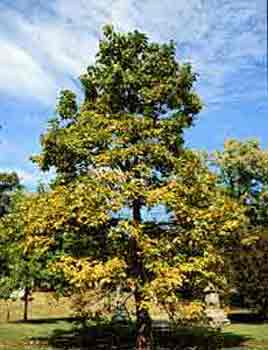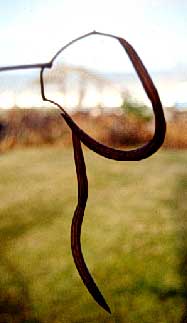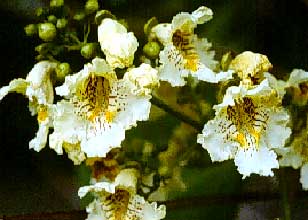 Northern Catalpa - Catalpa speciosa
Northern Catalpa - Catalpa speciosa
Bignonia Family (Bignoniaceae)
Northern catalpa has the showiest flowers of all the large trees native to Kentucky. However, it is more recognized for the long hanging pods that cling to the branches after the leaves fall. These pods give the tree its other common name, the cigar tree. It is native to western Kentucky, but has been planted throughout the state as an ornamental.
 Culture: Northern catalpa is a tough, adaptable tree that tolerates urbanization. It enjoys full sun or partial shade and moist, deep, fertile soil. Catalpa tolerates drought and can withstand a variety of soils and moisture levels, including poor, dry, wet or compacted soils. It will also tolerate alkaline sites. Potential problems of northern catalpa include powdery mildew, leaf spots, twig blight, mealybug infestation and Verticillium wilt. Northern catalpa drops its leaves throughout the summer as well as in the fall. It can be a messy tree when it drops its large leaves, twigs and pods. Because of its brittle wood, northerncatalpa tends to lose branches in storms.
Culture: Northern catalpa is a tough, adaptable tree that tolerates urbanization. It enjoys full sun or partial shade and moist, deep, fertile soil. Catalpa tolerates drought and can withstand a variety of soils and moisture levels, including poor, dry, wet or compacted soils. It will also tolerate alkaline sites. Potential problems of northern catalpa include powdery mildew, leaf spots, twig blight, mealybug infestation and Verticillium wilt. Northern catalpa drops its leaves throughout the summer as well as in the fall. It can be a messy tree when it drops its large leaves, twigs and pods. Because of its brittle wood, northerncatalpa tends to lose branches in storms.
- Native habitat: Southern Illinois and Indiana, south to western Tennessee and Arkansas.
- Growth habit: Northern catalpa has an irregular, oval crown.
- Tree size: This catalpa is a vigorous grower, reaching 40 to 60 feet in height at maturity with a 20- to 40-foot spread.
- Flower and fruit: Loose, upright panicles of fragrant, white, 2-inch, bell-shaped flowers with yellow and sometimes purple markings appear on branch tips in May and June. Stout, thick-walled, 8- to 20-inch pods contain fringed seeds and hang throughout winter.
- Leaf: Heart-shaped leaves are 6 to 12 inches long and 3 to 8 inches across and are borne on long petioles. They are smooth and medium green above and very downy below.
- Hardiness: Winter hardy to USDA Zone 4.
 Additional information: Although northern catalpa does not offer remarkable fall color, its large leaves have a beautiful shape and color that are ornamental in the summer. Fragrant, showy panicles of white flowers have ornamental value in May and June. Very long, stout brown pods hang on the tree throughout winter. Northern catalpa also has an attractive winter form.
Additional information: Although northern catalpa does not offer remarkable fall color, its large leaves have a beautiful shape and color that are ornamental in the summer. Fragrant, showy panicles of white flowers have ornamental value in May and June. Very long, stout brown pods hang on the tree throughout winter. Northern catalpa also has an attractive winter form.
Northern catalpa is more widely planted than the southern catalpa (Catalpa bignonioides). It is a larger and narrower tree than the southern catalpa and its pods are longer and stouter. It also has larger leaves and its flowers open about two weeks earlier than those of southern catalpa.
Northern catalpa has extremely durable wood that is rot- resistant. The wood is used for fence posts and railroad ties.
National champion trees are in Michigan (107 feet) and Washington (86 feet).


